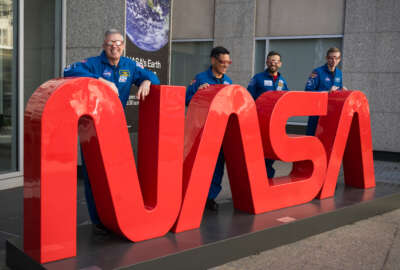Playing matchmaker for federal agencies and innovators
To help facilitate relationships, companies like BMNT make sure these partnerships actually produce what they intend to.
Federal Space projects require a lot of different organizations to take care of the many, many technical needs, whether for defense or exploration purposes. The problem is, many of those niche companies don’t exactly have long standing relationships with federal and defense agencies. To help facilitate those relationships, companies like BMNT which is a defense tech innovation firms to make sure these partnerships actually produce what they intend to. Ellen Chang, vice president with BMNT, shared her perspective on The Space Hour.
Interview transcript:
Ellen Chang So H4XLabs is a division that was started in 2019 to get at how do we help the government commercialize technology, often starting with [Small Business Innovation Research (SBIR)]? We started with the Navy, and we’ve grown into working with the Space Force back in 2021, where we really initially started with SpaceWorks. And that’s where we started to think about helping them define and think about what Orbital Prime could be. We weren’t exactly on contract at that time, but we were part of the whole effort of conceiving what Orbital Prime could be. Several of us were on some of the workshops. That later on translated into some of what we’re doing with the Space Force right now, which is with the SpaceWorks division, helping their Orbital Prime cohort of 41 companies develop in scale. The work breaks down into twofold. One is portfolio analysis. So looking across the 43 companies, what are they doing? What’s their technology maturation? All the way to how are they thinking about manufacturing for those hardware companies? To how are they thinking about funding? Not just government funding in terms of moving down the SBIR path, but some of these companies, about half of them actually have private capital in them. And how are they thinking about commercializing and returning to their investors. What markets are they attacking? How are they scaling? And so that’s been a very interesting effort. The other side of the coin of this work we’re doing is to support the companies themselves. So we have the assessments that we’ve been doing, and by understanding their pain points, we’re able to make the connections, or help inform how they should go about raising capital, for those that want to raise capital. How they should go about talking to different government entities who have similar requirements. And this moves into, or delves into, some of the other work we have with NASA, as well as now working with the Aerospace Corporation. But with NASA, we are working with their SBIR Ignite program, which is very similarly positioned. It’s focused on higher commercial impact. So within the SBIR program, NASA has their mainline program, which is their traditional program. Two years ago, they decided to start a pilot that gets at higher level technology readiness levels (TRL) – some of the companies that actually have already raised capital – so that they can commercialize technologies more quickly and be more intentional about where they’re funding, putting their investments. And so we’re involved in that, and we find that the synergies between these different space agencies are palpable. There can be domains where maybe there’s space control, which is more of a Space Force domain, yet there are some technologies that are useful for the civil space side. And because we’re seeing both sides, we’re able to make the connections and better inform both agencies.
Eric White Yeah, we’ve spoken to NASA folks from their SBIR program, and I was hearing a lot of the same terms you were using on commercializing a lot of the technology. Because some of the challenges that I’ve heard from folks from the commercial and public sector is that, this is such a unique and niche technology, or such unique and niche technologies are needed in this sector that there’s not sometimes enough of an onus to create them. What do you say to both sides, when you hear the government say, hey, we need this. And the company say, well, where’s the money at for that, to make that?
Ellen Chang Yeah, I think it really depends. So some of the small businesses, we’re on the small business side, really not on the large company side. Some of the small businesses probably should be asking more of those questions. Where I find this, the venture backed companies, interesting is that they’re targeting a market that probably the commercial world will start to pay for. And so, yes, they’re concerned about winning, maybe in Air Force parlance, a [Strategic Funding Increase (STRATFI)]. So long as there’s matching funds coming in, they see light at the end of the tunnel of hey, yes, they’re starting to actually gain some commercial traction. I think maybe the question is, will that commercial traction be large enough to sustain in whatever time frame? There’s lots of projections that commercial space, or space commerce, is going to be $3 trillion in the next 10 years. But it’s taking some time to get there. And I think these companies are looking to calculate, how do they sustain to the point where there is a tipping point where commercial revenues really do unlock more opportunity? I guess in answer to you, there’s really two sets of companies. The small businesses tend to continue to move forward and get other research contracts slowly commercializing. Then there’s the startups, which have some venture backed funding, are looking to the Space Force to fund some of it, but realize there’s other markets out there that they need to actually go address, otherwise they wouldn’t be able to raise venture. Most of the venture capitalists that are funding these companies have not yet bought into defense tech, they’re really funding space commerce.
Eric White First off, I want to ask Ellen Chang’s prediction: Where do you see the dollars really going? A lot of people get into space because it’s far away from, they think of it as, well, it’s not defense oriented, and it’s a way to work with the government that’s not providing any sort of lethal technology or anything like that. But now those lines are starting to blur a little bit there. What do you think about that? And is there going to be more folks who get into it just because of their love of space and exploration and all those good things? Are they going to maybe back off a little bit.
Ellen Chang I think it’s near term, far term. So near, near term, I think some of the venture-ish types of investments will back off a bit, because the government just is coming in a little bit more strongly. But this government is also being influenced, at least in my world, the space portfolio is being influenced by the fact that venture has come in over the last 5-10 years, and they’re like, Oh, there’s another funding source. So therefore we might want to leverage it, and already thinking about how to change how they buy capability. So I think it’s near term, because of the environment and the security situation, I think there’s going to be more opportunities within the government side. But I do see light at the end of the tunnel. And for investors, this is the hardest thing, the timing element. Is it five years or is it 10 years away? But I already see opportunities with insurers, or if somebody does figure out what that standard is for refueling, there’s certainly business already being talked about on how a satellite can be refueled, and what is that cost? Because there’s there’s business cases, there’s business studies that have shown that, Hey, if I can refuel and extend my satellite another five years, this is how much more revenue I can have. They make that trade off, and it’s starting to close because the technology and the capability to do this is coming down. It’s fascinating, some of the talent coming out of these, like Space X actually generates a lot of talent. These young engineers go there, learn a lot, get worked really hard, and then they pop out and they start companies. So I’ve worked with several of these teams that are actually quite inventive, and are quite driven, and are at least being successful at not just getting some government contracts, but also raising capital and getting initial contracts from, like, Starlink, for example. Starlink actually has a problem with its satellites potentially getting hit or possibly running into something. And so if they actually know about a potential conjunction early enough, and they’re able to dodge the bullet, so to speak, they save their satellite, they save fuel, etc. And so those are the types of business cases that are being talked about, at least for that sort of activity. There’s others, like gas stations in space. Orbit Fab is a company I’m pretty familiar with, which is staging gas stations. And will they end up refueling satellites? I think so. I think it’s a time. Is it next five years? Is the next 10 years? We don’t know.
Eric White We’re speaking with Ellen Chang, who is with H4X Labs, which is the space practice for BMNT. And so let’s talk innovation. What is the current state of the innovative practices being pushed through, and how is that going to affect those long term and short term investments? Because obviously, in no other sector of industry is innovation probably more at the forefront than in this realm.
Ellen Chang Yeah, I guess if we use innovation as technical invention and kind of new products and new businesses being built up, I think within the space sector, there’s increasingly folks are just coming in, they’re starting all the time. There’s certainly some have, the halo is off. A couple of years ago, a bunch of space startups went public, and they’re not doing that well on the public markets. Not to say that their businesses aren’t maturing, but it hasn’t really stopped the onslaught of companies being formed. March of 2022 the markets came down, interest rates went up. A lot of capital is sitting on the sidelines. And I think this year, 2023 was a challenging year to raise money, but we’re starting to see the venture markets open up for some of these space companies again in 2024. And so I think about in another couple of years, we’ll start to see some of these companies grow, mature their technology and actually close their business case. Why is this relevant to the federal market? What I see in the federal side is ideas around, how do we buy services and not own the systems? For example, I think the Air Force just did unveil their new strategy, their new organization. General Saltzman is looking at how to harness more commercial. And I believe that word commercial is not just kind of the large commercial companies, but also some of the startups that he’s been exposed to, because there’s probably a market that the government can buy from in the next five, 10, 15 years, where it doesn’t have to necessarily build and own and operate. And I think we’ll have to go through to talk through some of the policy issues that surface because of that. If a civil space thing is up there, doing something for the government, and something happens, whose fault is it, etc. Those are the things, those are the types of policy issues that we’re going to have to have conversations about, and already are starting to have conversations about.
Eric White Finishing up here. We talked about the uniqueness of a lot of these venture capital companies and small businesses that are making little parts of the technology that is needed to actually operate things up in space. I want to talk about your industry in particular. Do you all have a lot of competition in the field of being the go-between between the government and some of these smaller entities that they’re looking to work with. I don’t want to force you to name your competitors or anything like that, give them a shout out. But just how big is that, specifically in the space sector? How big has your industry itself become?
Ellen Chang I would say, yes, there’s competition, and it’s across the board. If one would want to say, who accelerates companies as kind of the universe of market, Y Combinator would be a competitor. But then we’re also competi-mates, because they’re funding companies that we would then help. And then within this sector, there’s a couple like Starburst, which is quite well known within this sector, and we were, I would say, competi-mates, frenemies, just like the whole industry is. It’s that they’re pretty competent at attracting and advising companies as well. TechStars itself has a mini-space practice. And then there’s a few others. So like even plug-and-play. I think it ranges from very, very commercial players to those that are familiar with the government. I feel that what sets us apart is that we’re pretty well networked with the defense side, the national security side. A lot of BMNT’s heritage is DoD. And so we know how the DoD operates. We think national security, we have hacking for defense that sources problems from across the different military organizations. And so that’s our heritage, and so we’re ending up playing to our strengths. I don’t know that the market is growing in leaps and bounds. It is a services oriented type of a business. And how we like to think, is not necessarily going to capture another contract, which is helpful. But I’m always thoughtful about what problem are we solving for the government? How are we solving that? Where can because of our heritage, and we have one foot in commercial, where can commercial actually add value without adding risk? And that’s that can be hard to think through. For example, just was it last year, Silicon Valley Bank imploded, and I think the DoD was pretty concerned about the number of companies that it had already funded that was dependent on venture capital, and Silicon Valley Bank, where that might go, to the tune where Janet Yellen had to step in and actually say, hey, we will, essentially, we’ll make sure the bank doesn’t fail. I guess since then, JP Morgan has bought them and bought First Republic, and has provided a pretty stable backing for a lot of the startup financing that these two banks were providing. So hopefully I answered the question where there is quite a bit of competition within this accelerated world, but we like to play a role where we lean into national security. We believe we can help companies understand the commercial side and the government side, and help them make the decision on what type of company they want to be. I will say I personally am not just defense tech-oriented. I’m not necessarily saying everyone needs to be an Anduril, where the government and the DoD will be your customer. I think many within the space sector, most companies are going to be dual use, where they’re going to be building for commercial they can actually support the government, and they need to be successful at both, because just the market is larger.
Copyright © 2025 Federal News Network. All rights reserved. This website is not intended for users located within the European Economic Area.
Eric White is news anchor and Federal Drive producer at Federal News Network.
Follow @FEDERALNEWSCAST






